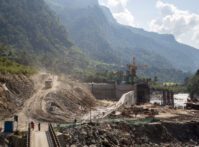-
Top 5 Posts for March 2022
April 19, 2022 By Claire Doyle
The devastation wrought by Russia’s invasion of Ukraine has shocked the world. But underneath the searing photographs and headlines, the war also highlights how access to natural resources shapes conflict—and how addressing regional resource needs is central to effective peacebuilding. For instance, the contentious North Crimean Canal cut off most of the water in occupied Crimea in 2014, leading to water insecurity and a loss of arable land. In our top post for March, Mehmet Altingoz and Saleem Ali discuss the role of water infrastructure in the years-long conflict between Russia and Ukraine and explain how water-sharing agreements could make critical contributions to peace.
The environment and diplomacy were also at the heart of March’s second top post, as Peter Schwartzstein offers a look ahead to COP 27, which will take place in Sharm el-Sheikh, Egypt, in November 2023. The conference could help propel climate action in the Middle East and North Africa (MENA)—one of the regions most exposed to the climate crisis—by shining a high-profile spotlight on growing environmental threats. COP27 promises both opportunities and risks for MENA’s environmental organizations, which have the potential to lead regional climate action but are chronically sidelined and underfunded.
Nancy Unger extends the conversation on environmental leadership to explore how women have spearheaded environmental progress in our third top post of the month. From Nobel Peace Prize winner Wangari Maathai to Hazel Johnson (who is often called “The Mother of the Environmental Justice Movement”), women have mobilized environmental action locally, regionally, and globally. One strategy they use, Unger writes, is leveraging narratives around maternalism to garner support for their environmental work.
The fourth top post for March is an open letter published by the Environmental Peacebuilding Association that also grapples with the environmental dimensions of the Russia-Ukraine conflict. Major environmental risks from the war span nuclear waste disasters, food insecurity, and water pollution, and the Association outlines key steps that the international community and Russia must take to prevent widespread environmental damage.
Shifting our gaze to the U.S. and China, Karen Mancl writes in March’s fifth top post that the agricultural sector’s heavy use of plastics poses more problems than it confers benefits. As plastics in farming become more prevalent, Mancl considers the impacts of agricultural plastic pollution and sheds light on what can be done to mitigate damage.
- Hydropolitics in the Russian – Ukrainian Conflict, by Mehmet Altingoz & Saleem Ali
- COP 27 in Sharm: Few Opportunities and More Challenges for MENA Environmentalists, by Peter Schwartzstein
- How Women’s Leadership Has Uniquely Shaped the Environmental Movement, by Nancy Unger
- The Environmental Dimensions of the Russian Invasion of Ukraine, featuring an excerpt from an open letter published by the Environmental Peacebuilding Association
- The Dirt on Agricultural Plastic Pollution of the Soil in the U.S. and China, by Karen Mancl
Photo Credit: Dry grass burns in the channel of the unused North Crimean Canal near the village of Razdolnoye (Crimea, Crimean Peninsula), courtesy of PhotoCrimea, Shutterstock.com.
 A Publication of the Stimson Center.
A Publication of the Stimson Center.








